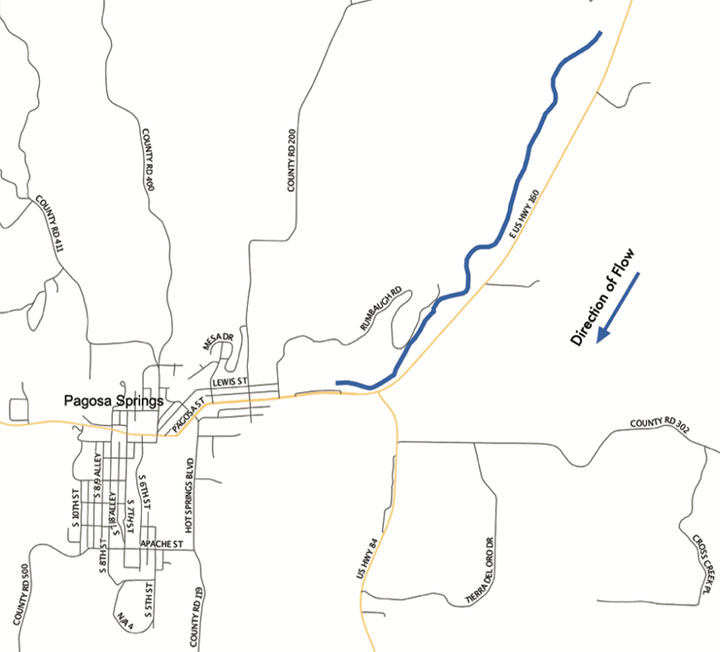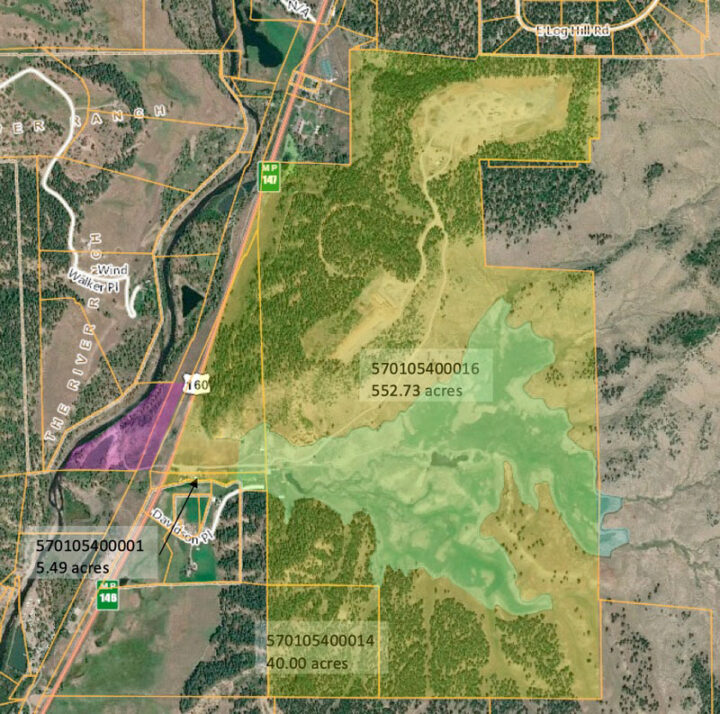On March 9, several San Juan Water Conservancy District board members — Candace Jones, Bill Nobles, Susan Nossaman, Al Pfister, Rod Proffitt, and Joe Tedder — met jointly with the Pagosa Area Water and Sanitation District board of directors — Peter Hurley, Bill Hudson, Jim Smith, Gene Tauges and Glenn Walsh — to discuss ‘items of mutual interest.’
The main community issue that connects the two water district boards, politically, is a three-way contract between SJWCD, PAWSD and the Colorado Water Conservation Board, concerning the handling of a $10 million debt obligation… related to a real estate purchase for a potential future water reservoir on the former Running Iron Ranch, in the Dry Gulch valley north of downtown Pagosa Springs.
The three-way contract obligates the PAWSD water customers to pay off the debt, and obligates SJWCD to try and get the reservoir built without any additional financial help from the PAWSD ratepayers. SJWCD is funded by about $90,000 a year in local property taxes. The proposed reservoir has been variously estimated at perhaps $100 million.
In Part One, however, we discussed a couple of other water projects that SJWCD and PAWSD might collaborate on. One, is a possible water line extension to provide a water fill station in Aspen Springs. Another is a potential housing project on the Running Iron Ranch property.
A third is a recreational rafting ‘put-in’ on the portion of the 660-acre Running Iron Ranch that adjoins the San Juan River. That ‘put-in’ is conceptually related to a potential three-mile ‘stream enhancement’ effort that’s been spearheaded by SJWCD President Al Pfister and other community members calling themselves ‘The Upper San Juan Water Enhancement Project’, more affectionately known as ‘the WEP’. The umbrella organization for the WEP is Durango-based Mountain Studies Institute.

Mr. Pfister has been a paid consultant on the WEP project.
The ‘enhancement’ of water, according to recent studies published by the WEP, might seem to involve ‘leaving more water in the San Juan River’ for recreational and environmental purposes. This could conceivably put the WEP effort at odds with the Dry Gulch Reservoir project, which would entail drawing water out of the San Juan River. But some people have argued that a reservoir could also ‘save water’ during the non-recreational season, and then release the water to benefit the rafting and fishing industries during the tourist season.
In connection with ‘enhancing’ the water in the river, the WEP has proposed a $1.5 million ‘enhancement’ project at San Juan River Village, to include a rafting put-in.
WEP has also proposed a $2 million ‘enhancement’ project for a three-mile stretch of the San Juan River, beginning at the Running Iron Ranch and ending at the east end of downtown Pagosa. That project has been promised taxpayer funding from SJWCD, the Town government, and the County government. Someday, we ought to have some conversations about who, exactly, this $2 million investment was supposed to benefit, because I doubt it would provide any noticeable benefit to 90% of Pagosa’s full-time residents.
To my knowledge — based upon hearing presentations of the $2 million “enhancement” project at three different WEP meetings — specific conversations about river access have not yet taken place, so it’s not clear how folks interested in aquatic recreation would benefit from the project. But taxpayer funding has nevertheless been promised.
The topic of put-ins did arise during the joint PAWSD-SJWCD meeting on March 9, however. We learned that the Town government does not want to be involved in building or managing a rafting put-in on the Running Iron Ranch property. But a representative of the rafting industry suggested that the Archuleta Board of County Commissioners might be interested in the project.
Here’s a map showing the property in question, marked in pink. The rest of the Running Iron Ranch is tinted yellow.

The PAWSD board was not opposed to seeing a rafting put-in built, but made it clear that someone other than the PAWSD customers would need to be financially responsible, and that the property might someday be sold to another entity — so any improvements were potentially temporary.
Disclosure: I currently serve on the PAWSD board of directors, but this editorial series reflects only my personal opinions and not necessarily the opinions of the PAWSD board as a whole.
The final topic on the joint meeting agenda was somewhat more contentious. The Dry Gulch Reservoir.
We’ll get back to the March 9 joint meeting tomorrow in Part Three. But first, we will note that the San Juan Water Conservancy District has taken on the job of finding partners for the Dry Gulch Reservoir project, and has reached out to the Southern Ute Tribe, who occupy a reservation stretching between Archuleta County and La Plata County. The following letter will be discussed today at the SJWCD board meeting, at 4pm at 46 Eaton Drive, Suite 5. You can download the meeting packet here.)
Dear Chairman Baker,
I am writing on behalf of the San Juan Water Conservancy District (SJWCD) to inform you and the Tribal Council of activities we are pursuing that we hope will enhance water availability in the Upper San Juan River, not only for residents of our District but also for downstream users. We are planning these activities in anticipation of a future warming and drying climate.
We recently met with staff from your Water Resources Division to initiate discussions on activities we are planning that may benefit the Southern Ute Reservation and its members. Our discussions focused mainly on SJWCD efforts in developing a reservoir upstream of Pagosa Springs (San Juan Headwaters Project). At the conclusion of our meeting, both parties agreed that we could each benefit from partnering to enhance water availability in the San Juan River. The specifics of such efforts would be determined as a result of future discussions with you and the Tribal Council. We believe such a partnership would benefit the agricultural, environmental, municipal, and recreational water users of our respective communities.
To facilitate additional discussion amongst the Southern Ute Tribe and the SJWCD, we would like to set up a meeting with the Tribal Council to outline our efforts, and discuss potential collective efforts that we could undertake to benefit our water users. Please contact me at apfister.sjwcd@gmail.com, or (970)985-5764, to set up a meeting at your convenience.
Allan (Al) Pfister
San Juan Water Conservancy District, President/Chair
